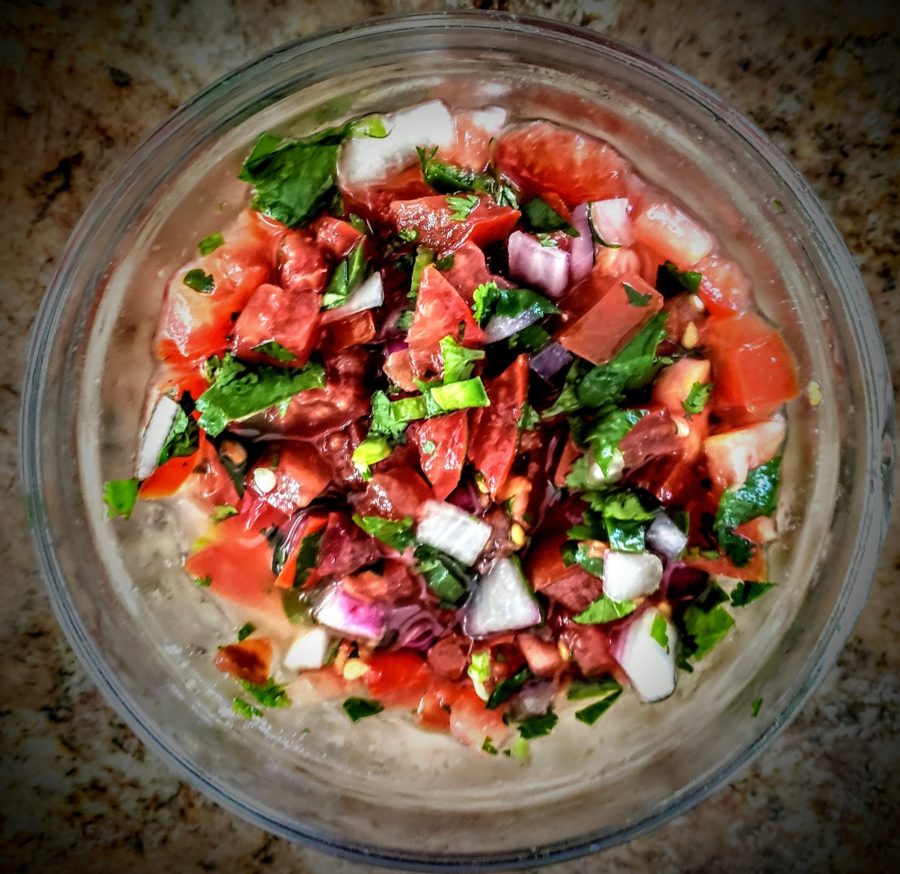Pico de Gallo is one of the most simple and popular Mexican sauces. This “salsa” is a must-to-serve dish over the tables of the Mexican restaurants, along with Nachos, Salsa Picante, and Salsa Tomatillo. Called also Salsa Bandera (flag sauce) because of the same colors of the Mexican Flag, Pico de Gallo is made with simple and healthy ingredients, without any fat adding: its vegan, and its delicious! Here the whole history and the traditional recipe!
If you like this recipe, please click here, leave a comment and vote 5 stars! This simple action helps the growth of this blog and make me very happy
Translated in Spanish, pico de gallo literally means “beak of rooster.” Some believe this is because it was originally eaten by pinching between the thumb and finger, making the shape of a rooster’s beak.

ORIGIN OF THE NAME
The origin of the name Pico de Gallo (rooster beak) is mysterious and has many interpretations.
The American food writer Sharon Tyler Herbst affirmed the name derives from the gesture to pick the single pieces between the thumb and the forefinger: similar to a rooster beak. It seems that in origin it was typical to eat the Salsa without any silverware.
Otherwise, in the book “Authentic Mexican: Regional Cooking from the Heart of Mexico”, Rick Bayless support the Idea Pico de Gallo is named in this way because of the size of the diced ingredients, close in shape to the bird-feed.
Another theory popular in Mexico tells that the vegetable pieces have to be as little as cut by a rooster beak, and spicy as like a peck on the tongue!
Finally, another tale maintains the Idea the name deduce the name from the shape of the Serrano peppers, similar to a rooster beak.
PICO DE GALLO VARIATIONS
The Classic Pico de Gallo recipe requires just five ingredients: ripe tomatoes, onion, Mexican green peppers, fresh cilantro, and lime juice. But, this timeless recipe can vary depending on the seasons, the regions, and the family history.
This salsa is popular in all of Mexico, particularly in the regions of Sonora, Yucatan, Guanajuato, and Oaxaca, with some variations. For instance, in Yucatan, it is called Xnipek (dog nose) and flavored with the extra spicy Habanero pepper.
An interesting variation is the sweet Pico de Gallo, made with seasonal fruit, lime, salt, and chili powder.
Besides the basic vegetables of Pico de Gallo, several chefs love to add other ingredients like radish, Jicama (Mexican potato), oranges, or watermelon.
Prepare a Pico de Gallo to perfection its easy, here some tips:
PEPPERS: the most popular pepper to make Pico de Gallo is Serrano, followed by the Jalapeno: I love to mix them. If you feel really, really brave, you can give a chance to Habanero, but be prepared to flames in your mouth!
ONIONS: either white or red are excellent choices: personally, I prefer red onion.
TOMATOES: you want the tomatoes perfectly ripe and juicy.
RESTING: I like to rest the Pico de Gallo to give to the vegetables the time to expel their tasty juice to enhance the flavor of the salsa.
Pico the Gallo is a very versatile recipe and pairs with a great variety of dishes.
The most simple pairing is certainly with the Guacamole: together they are a healthy and vegan bomb of tastiness!
Pico de Gallo is also great with fish, try it with tuna salad or grilled fish!
Another classic use of this salad is as an ingredient inside burritos or tacos or paired with fajitas.
PICO DE GALLO | The BEST Bowl of Salsa You Will Eat All Year Long (Authentic Mexican Recipe)
FAQ
Where does pico de gallo get its name from?
What do Americans call pico de gallo?
What makes pico de gallo different from salsa?
What do they call pico de gallo in El Salvador?
What is Pico de gallo?
Pico de gallo is translated as “rooster’s bill” in Spanish or “rooster’s beak”. It’s also called “salsa bandera” and “salsa fresca” which means fresh sauce. This dish has minimal liquid and focuses on the combination of the fresh ingredients and how they complement each other.
How did Pico de gallo get its name?
When it comes to the dish’s name, there are a few theories. Pico de Gallo can be translated to “rooster’s beak.” Sharon Herbst, a food writer, theorized that the way people used to eat the dish influences the name. Since it is a chunky consistency, people would eat the dip by using their thumb and forefinger to pick the food up.
What does ‘Pico de gallo’ mean in Rooster sauce?
The spices in the salsa gives the same feeling, hence “pico de gallo” is the beak of a fighting rooster biting your tongue! Much better explanation.. Me interesa que la salsa vietnamita también se llama “rooster sauce”. Jun 25, 2013 at 21:18
Why do Roosters eat Pico de gallo?
Pico de gallo translates literally to “rooster’s beak” in Spanish. Some believe this is due to the fact that it was initially eaten by pinching between the finger and thumb of the rooster, forming a beak shape. However, Pico de Gallo has no connection to a rooster or birds.
